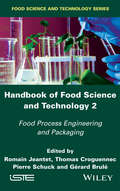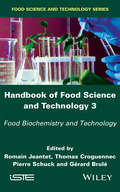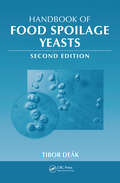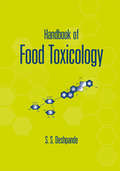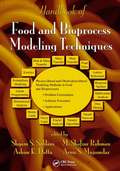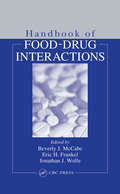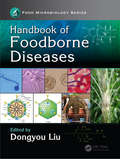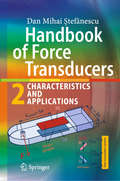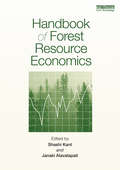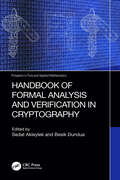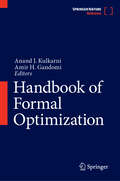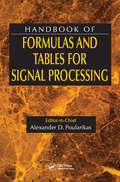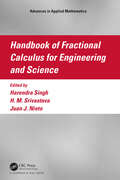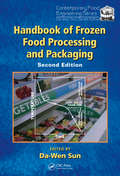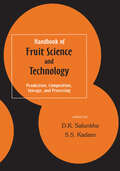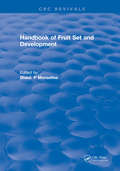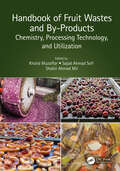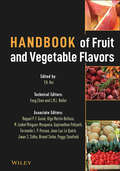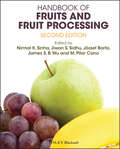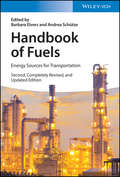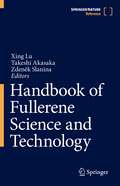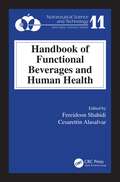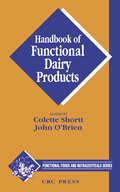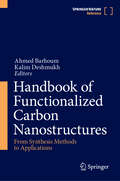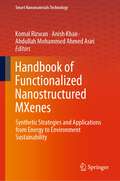- Table View
- List View
Handbook of Food Science and Technology 2: Food Process Engineering and Packaging
by Romain Jeantet Pierre Schuck Thomas Croguennec Gérard BruleThis book is a source of basic and advanced knowledge in food science for students or professionals in the food science sector, but it is also accessible for people interested in the different aspects concerning raw material stabilisation and transformation in food products. It is an updated and translated version of the book "Science des aliments" published in 2006 by Lavoisier. "Science des aliments" is a general and introductory food science and technology handbook, based on the authors' Masters and PhD courses and research experiences. The book is concise, pedagogical and informative and contains numerous illustrations (approximately 500 original figures and tables). In three volumes), it summarizes the main knowledge required for working in food industries as scientists, technical managers or qualified operators. It will also be helpful for the formation of students in food science and biotechnologies (bachelor's and master's degree).
Handbook of Food Science and Technology 3: Food Biochemistry and Technology
by Romain Jeantet Pierre Schuck Thomas Croguennec Gérard BruleThis third volume in the Handbook of Food Science and Technology Set explains the processing of raw materials into traditional food (bread, wine, cheese, etc.). The agri-food industry has evolved in order to meet new market expectations of its products; with the use of separation and assembly technologies, food technologists and engineers now increasingly understand and control the preparation of a large diversity of ingredients using additional properties to move from the raw materials into new food products. Taking into account the fundamental basis and technological specificities of the main food sectors, throughout the three parts of this book, the authors investigate the biological and biochemical conversions and physicochemical treatment of food from animal sources, plant sources and food ingredients.
Handbook of Food Spoilage Yeasts (Contemporary Food Science)
by Tibor DeakFar more than a simple update and revision, the Handbook of Food Spoilage Yeasts, Second Edition extends and restructures its scope and content to include important advances in the knowledge of microbial ecology, molecular biology, metabolic activity, and strategy for the prohibition and elimination of food borne yeasts. The author incorporates new
Handbook of Food Toxicology (Food Science and Technology)
by S.S. DeshpandeFrom health and economic consequences to exposure assessment and detoxification, this reference comprehensively covers the formation, characteristics, and control of various toxins that occur in the production, storage, handling, and preparation of food. The author discusses toxin sources, mechanisms, routes of exposure and absorption, and their chemical and biochemical components to prevent contamination of food products and reduce epidemics of foodborne disease. The book contains more than 3000 references to facilitate further research, as well as recent guidelines from the FDA and World Health Organization regarding food hygiene and safety.
Handbook of Food and Bioprocess Modeling Techniques
by Arun S. Mujumdar Ashim K. Datta Shyam S. Sablani M. Shafiur RahmanWith the advancement of computers, the use of modeling to reduce time and expense, and improve process optimization, predictive capability, process automation, and control possibilities, is now an integral part of food science and engineering. New technology and ease of use expands the range of techniques that scientists and researchers have at the
Handbook of Food-Drug Interactions
by Beverly J. McCabe Eric H. Frankel Jonathan J. WolfeWith contributions from the fields of pharmacy, dietetics, and medicine, Handbook of Food-Drug Interactions serves as an interdisciplinary guide to the prevention and correction of negative food-drug interactions. Rather than simply list potential food-drug interactions, this book provides explanations and gives specific recommendations based on th
Handbook of Foodborne Diseases (Food Microbiology)
by Dongyou LiuClearly linked to consumption of foods, beverages, and drinking water that contain pathogenic microbes, toxins, or other toxic agents, foodborne diseases have undergone a remarkable change of fortune in recent decades, from once rare and insignificant malaises to headline-grabbing and deadly outbreaks. Unquestionably, several factors have combined to make this happen. These include a prevailing demand for the convenience of ready-to-eat or heat-and-eat manufactured food products that allow ready entry and survival of some robust, temperature-insensitive microorganisms; a drastic reduction in the costs of air, sea, and road transportation that has taken some pathogenic microorganisms to where they were absent previously; an expanding world population that has stretched the boundary of human activity; and an ageing population whose weakened immune functions provide a fertile ground for opportunistic pathogens to invade and thrive. Given the diversity of causative agents (ranging from viruses, bacteria, yeasts, filamentous fungi, protozoa, helminthes, toxins, to toxic agents), and the ingenuity of pathogenic microbes to evolve through genetic reassortment, horizontal gene transfer, and/or random genetic mutation, it has become an enormous challenge to understand how foodborne agents are able to evade host immune defenses and induce diseases, and also to develop and apply innovative approaches for improved diagnosis, treatment, and prevention of foodborne diseases. Handbook of Foodborne Diseases summarizes the latest findings on more than 100 foodborne diseases and their causative agents. With contributions from international experts on foodborne pathogens, toxins, and toxic agents research, this volume provides state-of-the-art overviews on foodborne diseases in relation to their etiology, biology, epidemiology, clinical presentation, pathogenesis, diagnosis, treatment, and prevention. Apart from offering a comprehensive textbook for undergraduate and postgraduate students in food, medical, and veterinary microbiology, this volume constitutes a valuable reference on foodborne diseases for medical professionals and health authorities, and forms an informative educational resource for the general public.
Handbook of Force Transducers: Characteristics and Applications
by Dan Mihai ŞtefănescuPart I introduces the basic “Principles and Methods of Force Measurement” according to a classification into a dozen of force transducerstypes: resistive, inductive, capacitive, piezoelectric, electromagnetic, electrodynamic, magnetoelastic, galvanomagnetic (Hall-effect), vibrating wires, (micro)resonators, acoustic and gyroscopic. Two special chapters refer to force balance techniques and to combined methods in force measurement. Part II discusses the “(Strain Gauge) Force Transducers Components”, evolving from the classical force transducer to the digital / intelligent one, with the incorporation of three subsystems (sensors, electromechanics and informatics). The elastic element (EE) is the “heart” of the force transducer and basically determines its performance. A 12-type elastic element classification is proposed (stretched / compressed column or tube, bending beam, bending and/or torsion shaft, middle bent bar with fixed ends, shear beam, bending ring, yoke or frame, diaphragm, axial-stressed torus, axisymmetrical and voluminous EE), with emphasis on the optimum place of the strain gauges. The main properties of the associated Wheatstone bridge, best suited for the parametrical transducers, are examined, together with the appropriate electronic circuits for SGFTs. The handbook fills a gap in the field of Force Measurement, both experts and newcomers, no matter of their particular interest, finding a lot of useful and valuable subjects in the area of Force Transducers; in fact, it is the first specialized monograph in this inter- and multidisciplinary field.
Handbook of Forest Resource Economics (Routledge Environment and Sustainability Handbooks)
by Janaki R. R. Alavalapati Shashi KantIt is increasingly recognized that the economic value of forests is not merely the production of timber. Forests provide other key ecosystem services, such as being sinks for greenhouse gases, hotspots of biodiversity, tourism and recreation. They are also vitally important in preventing soil erosion and controlling water supplies, as well as providing non-timber forest products and supporting the livelihoods of many local people. This handbook provides a detailed, comprehensive and broad coverage of forest economics, including traditional forest economics of timber production, economics of environmental role of forests, and recent developments in forest economics. The chapters are grouped into six parts: fundamental topics in forest resource economics; economics of forest ecosystems; economics of forests, climate change, and bioenergy; economics of risk, uncertainty, and natural disturbances; economics of forest property rights and certification; and emerging issues and developments. Written by leading environmental, forest, and natural resource economists, the book represents a definitive reference volume for students of economics, environment, forestry and natural resource economics and management.
Handbook of Formal Analysis and Verification in Cryptography (Prospects in Pure and Applied Mathematics)
by Sedat Akleylek Besik DunduaThis handbook of formal analysis in cryptography is very important for secure communication and processing of information. It introduces readers to several formal verification methods and software used to analyse cryptographic protocols. The chapters give readers general knowledge and formal methods focusing on cryptographic protocols. Handbook of Formal Analysis and Verification in Cryptography includes major formalisms and tools used for formal verification of cryptography, with a spotlight on new-generation cryptosystems such as post-quantum, and presents a connection between formal analysis and cryptographic schemes. The text offers formal methods to show whether security assumptions are valid and compares the most prominent formalism and tools as they outline common challenges and future research directions. Graduate students, researchers, and engineers worldwide will find this an exciting read.
Handbook of Formal Optimization
by Amir H. Gandomi Anand J. KulkarniThe formal optimization handbook is a comprehensive guide that covers a wide range of subjects. It includes a literature review, a mathematical formulation of optimization methods, flowcharts and pseudocodes, illustrations, problems and applications, results and critical discussions, and much more. The book covers a vast array of formal optimization fields, including mathematical and Bayesian optimization, neural networks and deep learning, genetic algorithms and their applications, hybrid optimization methods, combinatorial optimization, constraint handling in optimization methods, and swarm-based optimization. This handbook is an excellent reference for experts and non-specialists alike, as it provides stimulating material. The book also covers research trends, challenges, and prospective topics, making it a valuable resource for those looking to expand their knowledge in this field.
Handbook of Formulas and Tables for Signal Processing (Electrical Engineering Handbook)
by Alexander D. PoularikasSignal processing is a broad and timeless area. The term "signal" includes audio, video, speech, image, communication, geophysical, sonar, radar, medical, and more. Signal processing applies to the theory and application of filtering, coding, transmitting, estimating, detecting, analyzing, recognizing, synthesizing, recording, and reproducing signals. Handbook of Formulas and Tables for Signal Processing a must-have reference for all engineering professionals involved in signal and image processing. Collecting the most useful formulas and tables - such as integral tables, formulas of algebra, formulas of trigonometry - the text includes:Material for the deterministic and statistical signal processing areasExamples explaining the use of the given formulaNumerous definitionsMany figures that have been added to special chaptersHandbook of Formulas and Tables for Signal Processing brings together - in one textbook - all the equations necessary for signal and image processing for professionals transforming anything from a physical to a manipulated form, creating a new standard for any person starting a future in the broad, extensive area of research.
Handbook of Fractional Calculus for Engineering and Science (ISSN)
by H. M. Srivastava Harendra Singh Juan J. NietoFractional calculus is used to model many real-life situations from science and engineering. The book includes different topics associated with such equations and their relevance and significance in various scientific areas of study and research. In this book readers will find several important and useful methods and techniques for solving various types of fractional-order models in science and engineering. The book should be useful for graduate students, PhD students, researchers and educators interested in mathematical modelling, physical sciences, engineering sciences, applied mathematical sciences, applied sciences, and so on. This Handbook: Provides reliable methods for solving fractional-order models in science and engineering. Contains efficient numerical methods and algorithms for engineering-related equations. Contains comparison of various methods for accuracy and validity. Demonstrates the applicability of fractional calculus in science and engineering. Examines qualitative as well as quantitative properties of solutions of various types of science- and engineering-related equations. Readers will find this book to be useful and valuable in increasing and updating their knowledge in this field and will be it will be helpful for engineers, mathematicians, scientist and researchers working on various real-life problems.
Handbook of Frozen Food Processing and Packaging (Contemporary Food Engineering)
by Da-Wen SunConsumer demand for a year-round supply of seasonal produce and ready-made meals remains the driving force behind innovation in frozen food technology. Now in its second edition, Handbook of Frozen Food Processing and Packaging explores the art and science of frozen foods and assembles essential data and references relied upon by scientists in univ
Handbook of Fruit Science and Technology: Production, Composition, Storage, and Processing (Food Science and Technology)
by D. K. Salunkhe S. S. KadamThis work offers comprehensive, current coverage of preharvest and postharvest handling and production of fruits grown in tropical, subtropical and temperate regions throughout the world. It discusses over 60 major and minor crops, and details developments in fruit handling and disease control, storage practices, packaging for fruit protection, siz
Handbook of Fruit Set and Development
by Shaul. P MonseliseDifferent phases of fruit development and utilization have been treated in many textbooks, reviews, and a host of scientific and professional papers. This seems, however, to be the first attempt to bring together case histories of so many different fruits and to present a balanced account of the whole period from set to harvest. Postharvest physiology, which has been in the centre of the picture in many former books, is at the bored line of the subject matter of this book, and has not been fully covered, except in a few cases. For this reason, two separate chapters deal with physiological and pathological aspects of fruit life after harvest.
Handbook of Fruit Wastes and By-Products: Chemistry, Processing Technology, and Utilization
by Khalid Muzaffar, Sajad Ahmad Sofi, and Shabir Ahmad MirProcessing of fruits produces large volumes of wastes and these wastes can create pollution problems and also result in loss of valuable biomass and nutrients. The Handbook of Fruit Wastes and By-Products: Chemistry, Processing Technology, and Utilization deals with the various techniques and methods involved in processing of fruit by-products. Although there are some general books on by-products of food processing industry but they are limited in context to the by-products of some particular fruits. This is the first book devoted to fruit processing by-products of wide range of important fruits including tropical, subtropical and temperate fruits; and their possible utilization in food and non-food industries. Key Features Discusses the valorization of fruit processing by-products Covers the role of the by-products as prebiotics and dietary fibers Presents extraction techniques of bioactive compounds from fruit wastes This book provides in-depth information about the fruit processing by-products, their nutritional composition, biochemistry, processing technology of by-products and the utilization of by-products into various food applications. This book also offers comprehensive coverage on the role of the fruit by-products as prebiotics and dietary fibers, their potential as the source of bioactive ingredients and their utilization in the development of novel functional foods. It also includes various novel technologies useful in extraction and evaluation of the functional components from these fruit processing by-products. The book addresses how the proper utilization of fruit processing by‐products would not only emerge as a source of extra profit to the fruit processing industry but also will help in lessen the environment pollution due to these fruit processing by-products.
Handbook of Fruit and Vegetable Flavors
by Peggy Stanfield Y. H. Hui Gopinadhan Paliyath Feng Chen L. M. Nollet Raquel P. F. Guin? Olga Mart?n-Belloso M. Isabel M?nguez-Mosquera Fernando L. P. Pessoa Jean-Luc Le Qu?r? Jiwan S. Sidhu Nirmal SinhaActing as chemical messengers for olfactory cells, food flavor materials are organic compounds that give off a strong, typically pleasant smells. Handbook of Fruit and Vegetable Flavors explores the flavor science and technology of fruits and vegetables, spices, and oils by first introducing specific flavors and their commercialization, then detailing the technical aspects, including biology, biotechnology, chemistry, physiochemistry, processing, analysis, extraction, commodities, and requirements for application as food additives. With chapter authors representing more than ten different countries, this handy reference provides a comprehensive view of this evolving science.
Handbook of Fruits and Fruit Processing: Production, Postharvest Science, Processing Technology And Nutrition
by Nirmal K. Sinha Jiwan S. Sidhu M. Pilar Cano József Barta James S. B. WuFruits are botanically diverse, perishable, seasonal and predominantly regional in production. They come in many varieties, shapes and size, colors, flavors and textures and are an important part of a healthy diet and the global economy. Besides vitamins, minerals, fibers and other nutrients, fruits contain phenolic compounds that have pharmacological potential. Consumed as a part of a regular diet, these naturally occurring plant constituents are believed to provide a wide range of physiological benefits through their antioxidant, anti-allergic, anti-carcinogenic, and anti-inflammatory properties. Handbook of Fruits and Fruit Processing distils the latest developments and research efforts in this field that are aimed at improving production methods, post-harvest storage and processing, safety, quality and developing new processes and products. This revised and updated second edition expands and improves upon the coverage of the original book. Some highlights include chapters on the physiology and classification of fruits, horticultural biochemistry, microbiology and food safety (including HACCP, safety and the regulation of fruits in the global market), sensory and flavor characteristics, nutrition, naturally present bioactive phenolics, postharvest physiology, storage, transportation and packaging, processing and preservation technologies. Information on the major fruits includes tropical and super fruits, frozen fruits, canned fruit, jelly, jam and preserves, fruit juices, dried fruits and wines. The 35 chapters are organized into five parts: Part I: Fruit physiology, biochemistry, microbiology, nutrition and health Part II: Postharvest handling and preservation of fruits Part III: Product manufacturing and packaging Part IV: Processing plant, waste management, safety and regulations Part V: Production, quality and processing aspects of major fruits and fruit products Each chapter has been contributed by professionals from around the globe representing academia, government institutions and industry. The book is designed to be a valuable source and reference book for scientists, product developers, students and all professionals with an interest in this field.
Handbook of Fuels: Energy Sources for Transportation
by Barbara ElversA guide to industrially relevant products and processes for transportation fuels The Handbook of Fuels offers a comprehensive review of the wide variety of fuels used to power vehicles, aircraft and ships and examines the processes to produce these fuels. The updated second edition reflects the growing importance of fuels and fuel additives from renewable sources. New chapters include information on current production technology and use of bioethanol, biomethanol and biomass-to-liquid fuels. The book also reviews novel additives and performanace enhancers for conventional engines and fuels for novel bybrid engines. This comprehensive resource contains critical information on the legal, safety, and environmental issues associated with the production and use of fuels as well as reviewing important secondary aspects of the use and production of fuels. This authoritative guide includes contributions from authors who are long-standing contributors to the Ullmann's Encyclopedia, the world's most trusted reference for industrial chemistry. This important guide: Contains an updated edition of the authoritative resource to the production and use of fuels used for transportation Includes information that has been selected to reflect only commercially relevant products and processes Presents contributions from a team of noted experts in the field Offers the most recent developments in fuels and additives from renewable sources Written for professionals in the fields of fossil and renewable fuels, engine design, and transportation, Handbook of Fuels is the comprehensive resource that has been revised to reflect the recent developments in fuels used for transportation.
Handbook of Fullerene Science and Technology
by Takeshi Akasaka Xing Lu Zdeněk SlaninaNanocarbon chemistry and physics is a fast-developing, broad research area – the Nobel prizes in 1996 and 2010 awarded to two key discoveries in the field, and several other nanocarbon achievements of comparable importance. Owing to this rapid growth, the nanocarbon landscape fundamentally changes every few years, creating a need to survey the field on a regular basis to update the books that have become incomplete or even obsolete. As such, this book focuses on fullerenes and metallofullerenes and also on the related areas of nanotubes and graphenes. All the covered research topics provide important fundamental knowledge for the natural sciences, but also for applications in molecular electronics, superconductivity, catalysis, photovoltaics and medical diagnostics. The current nanocarbon research activities have particularly high application potential in the conversion of solar energy, future molecular memories, non-conventional materials for optoelectronics, and new treatments for civilization diseases. Offering a truly up-to-date critical survey of nanocarbon science, its concepts and highlights, it follows the concept of a handbook: it addresses key topics systematically, from historical background, methodological aspects, current important issues, and application potential, all supplied with extensive referencing. With individual chapters written by leading experts with extensive research experience, it is a comprehensive reference resource for graduate students and active researchers alike.
Handbook of Functional Beverages and Human Health (Nutraceutical Science and Technology)
by Fereidoon Shahidi Cesarettin AlasalvarHandbook of Functional Beverages and Human Health provides potential applications and new developments in functional beverages, nutraceuticals, and health foods. In addition to serving as a reference manual, it summarizes the current state of knowledge in key research areas and contains novel ideas for future research and development. Additionally,
Handbook of Functional Dairy Products (Functional Foods and Nutraceuticals)
by John O’Brien Colette ShorttHandbook of Functional Dairy Products reveals key advances in the field, explores the product development process, and identifies the market dynamics driving product innovation. Chapters examine specific ingredients and products, safety and technology issues, the impact of biotechnology, the regulatory environment, and the communication of health benefits. With an emphasis on the potential contribution of functional dairy products in the maintenance of health and prevention of disease, the book includes in-depth discussions of probiotics, dairy-derived carbohydrates and prebiotics, bioactive peptides, the immune modulating effects of dairy ingredients, the health effects of conjugated linoleic acid (CLA), and calcium and iron fortifi
Handbook of Functionalized Carbon Nanostructures: From Synthesis Methods to Applications
by Ahmed Barhoum Kalim DeshmukhThis book highlights all newly reported carbon nanostructures including graphene and its derivatives, carbon nanotubes, metal organic frameworks, fullerenes, nanorods, nanospheres, nano onions, porous nanoparticles, nanohorns, nanofibers and nanoribbons, nanodiamonds, graphitic carbon nitrides, carbon aerogels and hydrogels, graphdiyne and graphenylene. It presents the historical development of carbon nanostructures technologies, different types and classifications, and different fabrication and functionalization techniques, including outer/inner surface functionalization and covalent and noncovalent functionalization. This Handbook discusses the unique properties of functionalized carbon nanostructures that can be obtained by modifying their structures, composition, and surface. It gives the reader an in-depth look at the current achievements of research and practice while pointing you ahead to new possibilities in functionalizing and using carbon nanomaterials. Finally, it covers the various applications of functionalized carbon nanostructures including adsorbents, additives, active materials in energy accumulating systems (batteries, hydrogen storage systems, and supercapacitors), filtering media, catalysts or supports for catalysts, sensors or substrates for sensors, additives for polymers, ceramic composites, metal and carbon alloys, glasses, digital textiles, and composite materials.
Handbook of Functionalized Nanostructured MXenes: Synthetic Strategies and Applications from Energy to Environment Sustainability (Smart Nanomaterials Technology)
by Anish Khan Komal Rizwan Abdullah Mohammed Ahmed AsiriThis book covers the various aspects of MXenes nanomaterials and its composites from the fabrication to the potential applications in energy devices, sensors, and environmental remediation. MXenes are two-dimensional (2D) transition metal carbides and nitrides which contains novel combination of properties including great conductivity and mechanical, thermal features of transition metal carbide and nitrides. In addition, MXenes nanomaterials possess high surface area, novel morphology, and layered structure and the functionalized of its surfaces gives it excellent hydrophilic characteristics and high absorption of electromagnetic radiations making them versatile materials for various applications. The beginning part of the book gives an in-depth literature covering the fundamental principles, fabrication, self-assembling strategies of nano-engineered MXenes, and their composites materials. The later chapters describe the chemical functionalization of MXenes nanomaterials for diversified applications such as electromagnetic shielding, energy storage devices (super capacitors, lithium ion batteries, CO2 capture, optical switching, transistors), photo catalysis, drug delivery, implants, tissue engineering, water purification, and sensing applications. It demonstrates that MXene-based advanced architectures promote continuous innovations and provide driving force in different fields particularly in environmental remediation and energy storage devices. This book is essential reading for all chemists, biologists, physicists, and environmental scientists working in the field of nanotechnology, energy, and environmental chemistry. It helps academics and professionals to polish their knowledge with the latest described data. It also helps professionals in developing innovative technologies by keeping in mind the applications of functionalized nanostructured MXenes.
